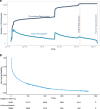How the weather affects the pain of citizen scientists using a smartphone app
- PMID: 31667359
- PMCID: PMC6811599
- DOI: 10.1038/s41746-019-0180-3
How the weather affects the pain of citizen scientists using a smartphone app
Abstract
Patients with chronic pain commonly believe their pain is related to the weather. Scientific evidence to support their beliefs is inconclusive, in part due to difficulties in getting a large dataset of patients frequently recording their pain symptoms during a variety of weather conditions. Smartphones allow the opportunity to collect data to overcome these difficulties. Our study Cloudy with a Chance of Pain analysed daily data from 2658 patients collected over a 15-month period. The analysis demonstrated significant yet modest relationships between pain and relative humidity, pressure and wind speed, with correlations remaining even when accounting for mood and physical activity. This research highlights how citizen-science experiments can collect large datasets on real-world populations to address long-standing health questions. These results will act as a starting point for a future system for patients to better manage their health through pain forecasts.
Keywords: Chronic pain; Epidemiology; Risk factors.
© The Author(s) 2019.
Conflict of interest statement
Competing interestsW.G.D. has received consultancy fees from Bayer Pharmaceuticals and Google, unrelated to this study. B.J. and B.H. are co-founders of uMotif. All other authors declare no competing interests.
Figures





References
-
- Hippocrates. On Airs, Waters and Places. http://classics.mit.edu//Hippocrates/airwatpl.html. (400 B.C.E.).
Grants and funding
LinkOut - more resources
Full Text Sources

